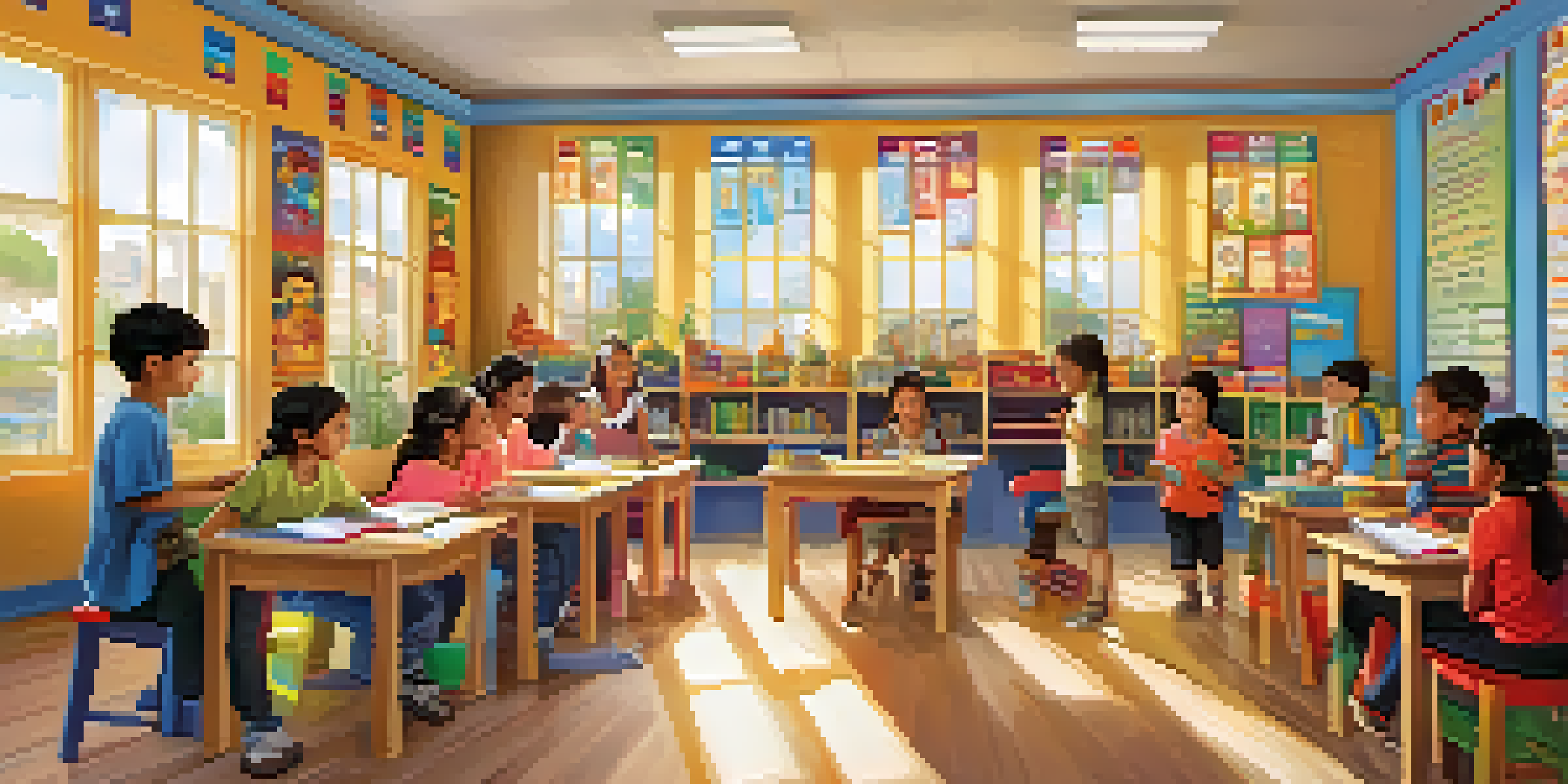The Benefits of Bilingual Education in Early Childhood

Understanding Bilingual Education in Early Childhood
Bilingual education refers to teaching children in two languages, typically their native language and a second language. This approach is especially effective in early childhood, where children's brains are like sponges, soaking up new information. By introducing multiple languages at a young age, we can help kids develop communication skills that are crucial for their future.
Bilingualism is not a gift; it is a skill that must be nurtured and developed over time.
In a bilingual classroom, children are often immersed in both languages through stories, songs, and interactive activities. This immersive experience not only makes learning fun but also helps children see language as a living entity. They begin to understand that language is a tool for connection and expression, which is a vital part of their development.
Moreover, early exposure to bilingual education can lead to a more profound understanding of cultural nuances. Children learn to appreciate diversity, which fosters empathy and social skills. In a world that is increasingly interconnected, these skills are invaluable.
Enhanced Cognitive Development Through Bilingualism
Research suggests that children in bilingual education programs often outperform their monolingual peers in cognitive tasks. This boost in cognitive abilities can be attributed to the mental juggling required to switch between languages. Such activities enhance problem-solving skills, creativity, and critical thinking.

Being bilingual also helps develop executive function skills, which include planning, attention, and multitasking. These skills are essential as children grow and face more complex challenges in school and life. Essentially, bilingual education sets a strong foundation for lifelong learning.
Cognitive Benefits of Bilingualism
Bilingual education enhances cognitive abilities, leading to improved problem-solving, creativity, and critical thinking skills.
Furthermore, studies have shown that bilingual individuals tend to have better memory and can focus more effectively. These cognitive benefits are not just limited to academic settings but also translate into everyday situations, giving bilingual children an edge in various aspects of life.
Social and Emotional Benefits of Bilingual Education
Bilingual education doesn't just shape cognitive abilities; it also nurtures social and emotional development. Children who learn in two languages often have greater social skills, as they can connect with a wider range of peers. This ability to communicate across cultures fosters friendships and enhances their social circles.
The limits of my language mean the limits of my world.
Moreover, being bilingual can boost a child's self-esteem. As they learn to navigate different languages and cultures, they develop a sense of identity and pride in their heritage. This confidence can lead to more positive interactions with others, reinforcing their social bonds.
Additionally, bilingualism allows children to express themselves in multiple ways, which can be especially beneficial during emotional development. It gives them the tools to articulate their feelings in different contexts, which is an essential skill for emotional intelligence.
Cultural Awareness and Appreciation in Bilingual Learning
Bilingual education naturally encourages cultural awareness and appreciation. When children learn a second language, they are also introduced to the traditions, values, and histories of the cultures that speak that language. This exposure fosters an understanding of global perspectives and promotes inclusivity from a young age.
For instance, storytime in a bilingual classroom may involve tales from both cultures, allowing children to compare and contrast different narratives. Such activities help children appreciate diversity and recognize the richness of different cultural experiences.
Social Skills and Emotional Growth
Learning in two languages fosters greater social skills and boosts self-esteem, helping children connect with diverse peers.
As they grow, these children are often more open-minded and adaptable, qualities that are essential in our increasingly diverse world. This cultural competence is not just beneficial for personal growth; it also prepares children to navigate a global society with ease.
Improved Academic Performance Linked to Bilingual Education
Bilingual education has been linked to improved academic performance in various subjects. Students who are proficient in two languages often excel in reading, writing, and even math. This is largely due to the cognitive benefits associated with bilingualism, which enhance overall learning capabilities.
In addition, bilingual education fosters a love for learning. When children are engaged in diverse linguistic and cultural activities, they are more likely to develop a curiosity about the world around them. This enthusiasm can lead to greater academic success as they progress through their education.
Furthermore, bilingual students often show increased resilience in facing academic challenges. The skills they develop in navigating two languages prepare them to tackle complex problems and adapt to new situations, which is a tremendous advantage in any educational setting.
Long-Term Career Advantages of Bilingualism
In today's global job market, bilingualism is a significant asset. Employers often seek candidates who can communicate with diverse populations, making bilingual individuals highly desirable. This advantage can lead to better job opportunities and potentially higher salaries.
Moreover, bilingual employees tend to be more adaptable and culturally aware. These traits are increasingly important in a workplace that values collaboration and diversity. As businesses expand globally, having team members who can bridge language gaps becomes crucial.
Cultural Awareness Through Language
Bilingual education promotes cultural appreciation, enabling children to understand and embrace diverse perspectives from a young age.
In essence, early bilingual education sets the stage for a future where children can thrive professionally. By investing in bilingual learning, we are not just enhancing their academic skills but also opening doors to a world of possibilities.
Challenges and Considerations in Bilingual Education
While the benefits of bilingual education are clear, it's essential to acknowledge the challenges that may arise. One concern is the balance between two languages; parents and educators must ensure that children are proficient in both without neglecting one language. This requires a thoughtful approach to teaching and consistent practice in both languages.
Another consideration is the availability of quality bilingual programs. Not all educational institutions have the resources or trained staff to implement effective bilingual education. Parents may need to research options carefully to find a suitable program for their children.

Lastly, societal attitudes toward bilingualism can influence a child's experience. In some communities, there may be a stigma attached to speaking a second language, which can discourage children from fully embracing their bilingual identity. It's crucial to foster an environment that celebrates bilingualism and encourages children to take pride in their language skills.